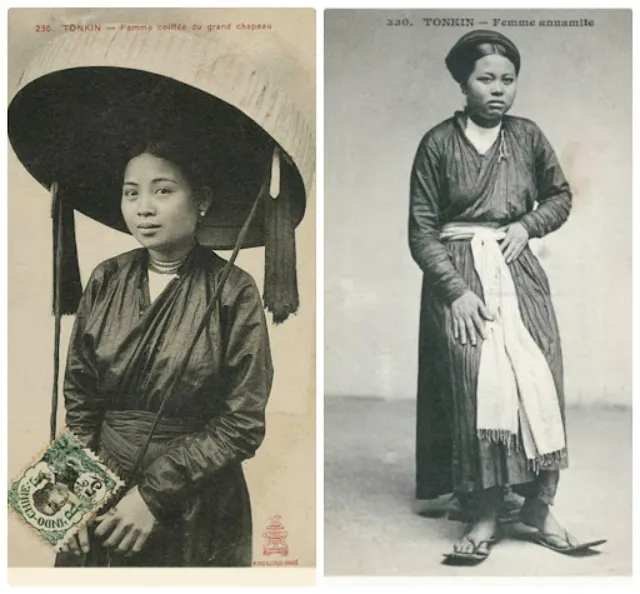The Ao Dai, a symbol of Vietnamese beauty, is more than just clothing; it is an integral part of the nation’s culture and history. This elegant garment has undergone numerous transformations, evolving from attire exclusively for the nobility to a beloved outfit for Vietnamese women from all walks of life. Let’s explore the fascinating journey of the Ao Dai’s history to better understand its profound cultural value.
Origins and Formation of the Ao Dai
The history of the Vietnamese Ao Dai began very early, with its precursor being the ‘áo giao lĩnh’ which appeared around the 17th century. The ‘áo giao lĩnh,’ a loose-fitting garment with two panels split at the sides, bears the rudimentary form of today’s Ao Dai. This garment was typically worn with a ‘yếm’ (an undergarment) inside, combined with a sash and a black skirt, creating a discreet and elegant look.

The next development was the ‘áo tứ thân,’ which emerged in the 18th century. The ‘áo tứ thân’ is considered a significant step in the formation of the Ao Dai. While still maintaining the split-panel design, the ‘áo tứ thân’ was sewn with separate front panels that could be tied together, providing greater convenience for women in daily activities and labor.
Ao Dai Ngu Than: Class Differentiation
In the 19th century, during the reign of King Gia Long, the ‘áo ngũ thân’ was created, marking a significant transformation in the history of the Vietnamese Ao Dai. The ‘áo ngũ thân’ has a similar design to the ‘áo tứ thân,’ but with an added fifth panel, symbolizing discretion and sophistication.

The emergence of the ‘áo ngũ thân’ was not only a change in design but also signified social class differentiation. The ‘áo ngũ thân’ became attire for the nobility and mandarins, representing a distinction from the clothing of the working class.
Ao Dai Lemur: A Revolutionary Innovation
In the early 20th century, the Vietnamese Ao Dai witnessed a significant innovation with the advent of the Ao Dai Lemur in 1939. Artist Cát Tường, also known as Le Mur in French, created a completely new style of Ao Dai, deeply influenced by Western fashion.
The Ao Dai Lemur was tailored to be form-fitting, accentuating the feminine curves. Details like puffed sleeves and a heart-shaped neckline were inspired by Western dresses, creating a fashionable and modern look. However, the Ao Dai Lemur also caused much controversy due to its unconventional departure from tradition.

Ao Dai Le Pho: Blending Tradition and Modernity
Following the Ao Dai Lemur, artist Lê Phổ made significant improvements, creating the Ao Dai Le Pho in the 1950s. The Ao Dai Le Pho is a harmonious blend of tradition and modernity. Details considered incompatible with Vietnamese culture were removed, replaced by discretion, elegance, and grace.
The Ao Dai Le Pho features long panels, a form-fitting silhouette, non-puffed sleeves, and a modest neckline with a row of buttons on the right side. This style quickly became popular and was beloved by Vietnamese women for a long time.
Ao Dai Raglan: Convenience and Sophistication
In the 1960s, the Ao Dai Raglan, also known as ‘áo dài ráp-lăng’, emerged, bringing convenience and comfort to the wearer. The Ao Dai Raglan is tailored to fit closely to the body, combined with a sleeve attachment from the neck diagonally downwards, which helps minimize wrinkles at the armpits and allows for flexibility in movement.

Ao Dai Ba Nhu: A Personal Touch
Also in the 1960s, the Ao Dai Ba Nhu, or the boat-neck Ao Dai, designed by Trần Lệ Xuân, caused much public debate. The Ao Dai Ba Nhu removed the collar, creating a more sensual and liberal look. Despite initial opposition, this style later became popular due to its simplicity and comfort.
Traditional Ao Dai: Timeless Beauty
From the 1970s to the present day, the traditional Vietnamese Ao Dai was officially established and has been preserved to this day. The traditional Ao Dai is the epitome of the nation’s cultural, historical, and aesthetic values.

Through the ups and downs of history, the Ao Dai has always been a symbol of Vietnamese beauty and a source of national pride. The Ao Dai is not just clothing, but an indispensable part of Vietnamese culture and life.
Modern Ao Dai: Continuous Creativity
Alongside the traditional Ao Dai, the modern Ao Dai is also increasingly favored. The modern Ao Dai brings novelty, uniqueness, and suitability for modern life.

With diverse designs, the modern Ao Dai still retains the grace and elegance of the traditional Ao Dai while providing comfort and convenience for the wearer.
Ao Dai Fabric Materials: Diversity and Richness
To create a beautiful Ao Dai, the fabric material plays a crucial role. Many types of fabric are used to tailor Ao Dai, each offering a different beauty and feel.
Silk Ao Dai: Softness and Allure
Silk is one of the most preferred materials for tailoring Ao Dai. Silk Ao Dai offers softness, smoothness, and comfort to the wearer. The silk material also enhances the figure and creates a special impression.

Brocade Ao Dai: Luxury and Nobility
Brocade is a material often used to tailor classic Ao Dai. Brocade Ao Dai brings luxury, nobility, and highlights the delicate lines of the garment.

Jacquard Fabric: A Choice for the Connoisseur
Jacquard fabric is less commonly used for tailoring Ao Dai, but it is still favored by some older people for the luxury and nobility it brings.
Conclusion
The history of the Vietnamese Ao Dai is a fascinating and meaningful journey. From royal costume to cultural symbol, the Ao Dai has undergone many transformations and vicissitudes to become an indispensable part of Vietnamese life. The Ao Dai is not just clothing, but also a source of pride, a symbol of Vietnamese beauty and culture. Let’s preserve and promote the beautiful values that the Ao Dai brings, so that the Vietnamese Ao Dai may forever endure through time.